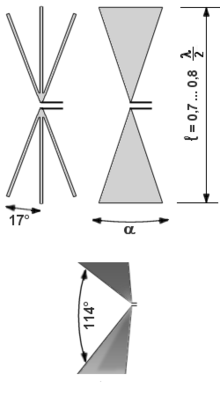Surface dipole
Surface dipoles are special forms of antenna dipoles whose wire thickness takes on the dimensions of a surface and which are mainly used as a receiving antenna for the VHF and UHF range .
They are flat half-wave or full-wave dipoles whose frequency dependence of the base point impedance remains low over a relatively large frequency range and which are therefore used as broadband antennas.
Examples of surface dipoles are the butterfly dipole (or spreading dipole) and the fan dipole . Impedance , shortening factor and bandwidth are determined by the spread angle α . The increased capacitive effect of the extremely widened dipole ends causes an additional shortening of the length of the dipole.
Both designs can be set up flat or at an angle to the front. An opening angle of 114 ° has proven to be favorable in practical operation.
The flat design can also be mounted in front of a reflector wall or even be part of a Yagi antenna . Despite the obvious radiator area, flat and fan- shaped dipoles are still linear antennas due to their electrical properties , so they are not classed as flat antennas .
literature
- Alois Krischke: Rothammels Antennenbuch. 11th edition, Franckh-Kosmos-Verlags-GmbH, Stuttgart 1995, ISBN 3-440-07018-2
